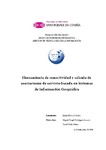Herramienta de conectividad y cálculo de asociaciones de servicio basada en Sistemas de Información Geográfica

Use this link to cite
http://hdl.handle.net/2183/32075
Except where otherwise noted, this item's license is described as Atribución-CompartirIgual 3.0 España
Collections
Metadata
Show full item recordTitle
Herramienta de conectividad y cálculo de asociaciones de servicio basada en Sistemas de Información GeográficaAuthor(s)
Directors
Rodríguez Luaces, MiguelTrillo Pérez, David
Date
2022Center/Dept./Entity
Universidade da Coruña. Facultade de InformáticaDescription
Traballo fin de grao (UDC.FIC). Enxeñaría Informática. Curso 2021/2022Abstract
[Resumen]: El objetivo de este fin de grado es desarrollar una herramienta basada en el SIG de escritorio QGIS, que permita realizar validaciones de conectividad y cálcular asociaciones de servicio en modelos de red compuestos por conjuntos de elementos de diferentes capas. Además, se incorporará una sección mediante la cual el usuario podrá escoger qué capas se tienen en cuenta a la hora de realizar dichas operaciones mencionadas anteriormente. Para alcanzar los objetivos de este trabajo, se ha realizado un estudio detenido de QGIS y las diferentes herramientas que éste provee para el desarrollo de plugins incorporados en él. Una vez analizadas dichas herramientas, se procedió a utilizarlas para desarrollar los algoritmos y realizar las pruebas pertinentes. Para el desarrollo de la herramienta, en cuanto a base de datos, se ha utilizado una base de datos PostgreSQL existente, proveída por la empresa Avansig que contiene los datos municipales de Ourense necesarios para el programa EIEL (Encuesta de Infraestructura y Equipamiento Local). En cuanto a código, éste se ha desarrollado en Python, utilizando las librerías PyQGIS y PyQt propias de QGIS (parte SIG) y Qt (interfaces de usuario) respectivamente. Para la visualización de datos se ha utilizado la interfaz del propio QGIS y el gestor de BBDD Dbeaver. Este trabajo de fin de grado se gestionó siguiendo una metodología iterativa e incremental para el desarrollo software, en la que en cada iteración se llevaba a cabo una funcionalidad del sistema. [Abstract]: The objective of this end-of-degree assignment is to develop a tool based on desktop GIS QGIS, which allows performing connectivity validations and calculating service associations in network models composed of sets of elements from different layers. In addition, a section will be incorporated through which the user will be able to choose which layers are taken into account when carrying out the aforementioned operations. To achieve the objectives of this work, a detailed study of QGIS and the different tools that it provides for the development of plugins incorporated in it has been carried out. Once these tools were analyzed, they were used to develop the algorithms and carry out the relevant tests. For the development of the tool, in terms of database, an existing PostgreSQL database has been used, provided by the company Avansig, which contains the municipal data of Ourense necessary for the EIEL program (Survey of Infrastructure and Local Equipment). As for the code, it has been developed in Python, using the PyQGIS and PyQt libraries of QGIS (GIS part) and Qt (user interfaces) respectively. For the visualization of data, the interface of QGIS itself and the DB manager Dbeaver have been used. This end-of-degree project was managed following an iterative and incremental methodology for software development, in which a system functionality was carried out in each iteration.
Keywords
Python
PyQGIS
PyQt
QGIS
PostgreSQL
Extensión QGIS
Herramienta de conectividad
Asociación de servicio
QGIS extension
Conectivity tool
Service association
PyQGIS
PyQt
QGIS
PostgreSQL
Extensión QGIS
Herramienta de conectividad
Asociación de servicio
QGIS extension
Conectivity tool
Service association
Rights
Atribución-CompartirIgual 3.0 España






